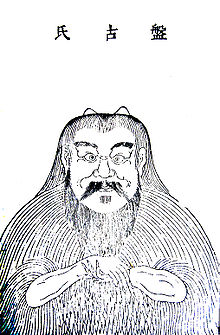Pangu

Pangu ( Chinese 盤古 / 盘古 , Pinyin Pángǔ , also: 盤古 氏 / 盘古 氏 , Pángǔshì - "Venerable Pangu", outdated: 柈 古 or 柈 古 氏 ) is the first living being on earth in Chinese mythology .
World creation myth
From the nondual, attributeless and formless primordial state of the universe, a cosmic egg arose in which the primordial being Pangu was. The primal being Pangu in the World Egg corresponds to Taiji , in Pangu Yin and Yang (two complementary poles that are both the origin and the essence of all things) are united. Then Pangu broke the egg in half and egg whites and yolks flowed out, yin and yang were divided. The egg white became the sky and the clouds (Yang), and the egg yolk became the earth (Yin).
As a world axis, Pangu is at the center of heaven and earth. His figure must have been dwarfish at first. Every day the sky grew upwards and the earth solidified and sank downwards. Pangu grew at the same rate until, after 18,000 years, it had become a giant whose body reached from earth to heaven.
He ended his life through self-sacrifice and formed the universe out of his body in a cosmogony . His breath became the wind, his voice became thunder , the left eye became the sun, the right eye formed the moon, the four poles and the five main mountains formed out of his body, his blood gave the rivers, teeth and bones made the metals, his Hair the plants, his saliva the rain and the vermin clinging to it mankind. Seed and bone marrow turned into pearls and jade .
Similar myths
Similar primeval beings, who created the world out of themselves, were in the mythology of the Kalmyks Manzaschiri, whose name is derived from the Bodhisattva Manjushri , in the Nordic mythology the giant Ymir and the Indian primitive man Purusha .
literature
- Josef Guter : Lexicon of the gods and symbols of the ancient Chinese. Marix, Wiesbaden 2004, ISBN 3-937715-04-5 , pp. 256f
Web links
- Micha F. Lindemans: Pan-gu. In: Encyclopedia Mythica .
Individual evidence
- ^ I. Robinet, Paula A. Wissing: The Place and Meaning of the Notion of Taiji in Taoist Sources Prior to the Ming Dynasty, History of Religions Vol. 29, No. 4 (May, 1990), pp. 373-411 (English)
- ↑ Pangu, Chinese Creator of the World , accessed September 15, 2019
- ↑ Uno Harva : The religious ideas of the Altaic peoples. FF Communications N: o 125.Suomalainen Tiedeakatemia, Helsinki 1938, p. 111
- ↑ Pierre Grimal (ed.): Myths of the peoples. Volume 2. Fischer, Frankfurt 1977, pp. 268-270